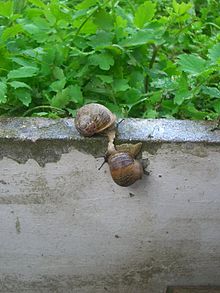
Reproduction
 To
find out more about the reproductive habits of Fumonelix
archeri, we will take a look at the terrestrial gastropod
lifecycle. As seen to the right, their lifecycle includes three
major stages: the egg, juvenile, and adult. Instead of going
through a larval stage, these snails simply go from the egg, to
a smaller version of the adult, to the mature adult. One main difference
between terrestrial and aquatic gastropods is that land snails
lack a veliger larval stage (Herbert,
2007). Pulmonates have a couple ways to make up for their
lack of a veliger stage, some of those methods being developing
at a faster rate than their marine relatives, as well as
beginning reproduction at an earlier age than marine species do
(Herbert,
2007).
To
find out more about the reproductive habits of Fumonelix
archeri, we will take a look at the terrestrial gastropod
lifecycle. As seen to the right, their lifecycle includes three
major stages: the egg, juvenile, and adult. Instead of going
through a larval stage, these snails simply go from the egg, to
a smaller version of the adult, to the mature adult. One main difference
between terrestrial and aquatic gastropods is that land snails
lack a veliger larval stage (Herbert,
2007). Pulmonates have a couple ways to make up for their
lack of a veliger stage, some of those methods being developing
at a faster rate than their marine relatives, as well as
beginning reproduction at an earlier age than marine species do
(Herbert,
2007).
To reproduce, pulmonate
snails like Fumonelix archeri are mostly monoecious,
meaning that each individual has both male and female reproductive
organs (Hickman
et al, 2009). They reach sexual maturity at a fairly early age,
and when they do, they engage in a courtship before mating that can
last anywhere from two to twelve hours (Pulmonates,
2010).

To
mate, one snail fertilizes another by putting its penis in the
other's genital pore; therefore fertilization is internal (Pulmonates,
2010). The snails will then bury their eggs in a
shallow layer of soil, or under leaves and foliage, where there is
warmth, protection, and moisture, all things required for the proper
hatching of eggs (NatureServe
Explorer, 2010). The eggs will remain there for two to four
weeks until they hatch, and the cycle of life repeats (Allison,
2012).
To take a better look at any of the previous pages, follow the
links.
To return to the Classification page click
here.
To return to the Habitat page click
here.
To return to the Adaptations page click
here.
To return to the Nutrition page click
here.
To go back to
the home page click
here.